People
6 Buzz-Worthy Artists on Their Personal Fashion and the Designers Who Influence Their Practice
Some unexpected studio accessories, from a Moschino Couture Trash-Can Bag to a vintage Muhammad Ali Sweatshirt.
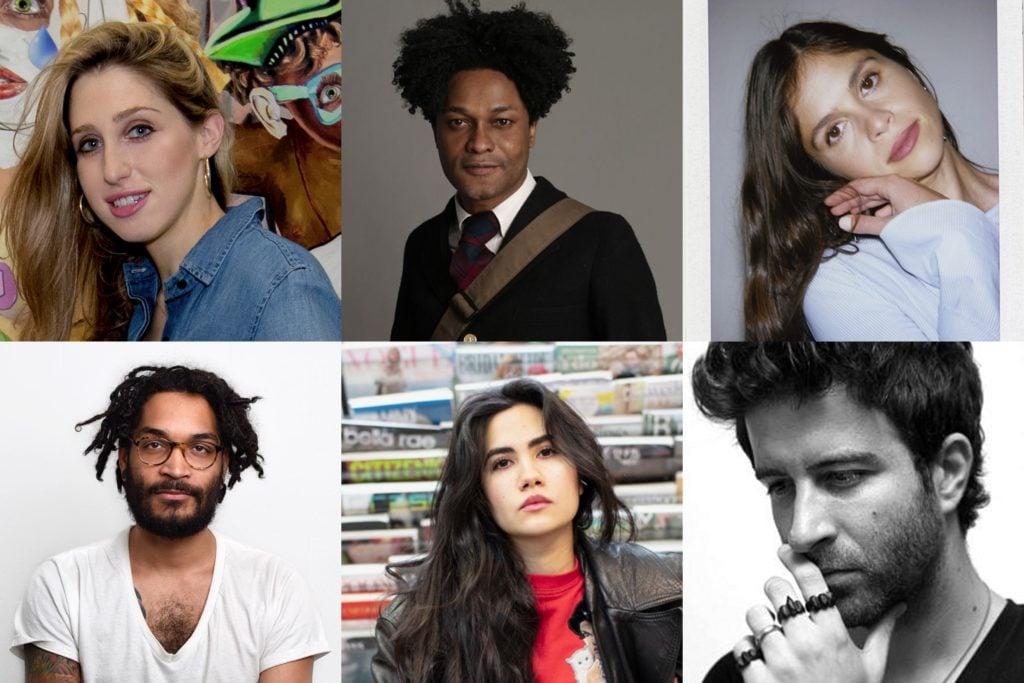
Some unexpected studio accessories, from a Moschino Couture Trash-Can Bag to a vintage Muhammad Ali Sweatshirt.

Caroline Goldstein

The lines that once strictly separated fashion from fine art have just about eroded completely. Gone with them is any doubt about the interlacing of cultural identity, personal style, and social commentary. There are fashion designers showing their work in art museums, and veritable art historical paintings gracing the collections of designer fashion labels.
Art Basel Miami Beach may be ground zero for this blurring. To mark it, here we’ve asked six artists about their style-influences, most coveted items, and what designers they admire most.
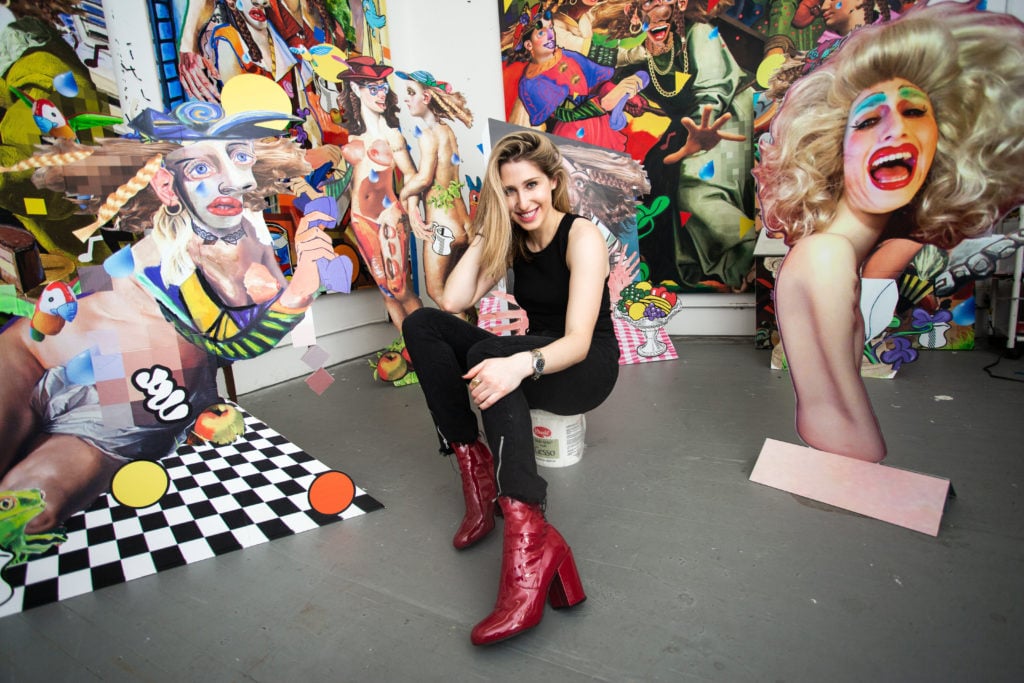
Allison Zuckerman, 2018. Courtesy of the artist.
The 28-year old phenom blasted into the forefront of the art market through sheer will: Hustling her paintings on Instagram generated buzz, and that buzz landed her a debut show at the Rubell Collection in Miami, which is known for anointing such young up-and-comers as Oscar Murillo and Cy Gavin. The break cemented Zuckerman’s spot in the big leagues. Since then, the Harrisburg, Pennsylvania native has shown around the country, and has a solo show at the Akron Art Museum that runs through January 2019. For fair week, she’s exhibiting at Kravets Webhby’s booth at UNTITLED in Miami Beach.
What fashion labels do you admire? How would you characterize their artistic vision?
I’m in love with Jeremy Scott’s vision for Moschino. Humor, joy, and subversion are clearly at play within every collection, and I find that to be incredibly exciting. Designers Cami James and Nadia Napreychikov, of Discount Universe, make empowering and unique looks that revel in irreverence and maximalism, while tackling themes of female objectification and misogyny.

Allison Zuckerman, Jilted Lover (2018). Courtesy of the artist and Kravets Wehby Gallery.
Are there any fashion designers who inspire you?
I was very inspired by Gucci’s creative director, Alessandro Michele’s “Cyborg” concept for Milan’s 2018 autumn/winter fashion week. Many of the models carried silicon cast replicas of their own heads while they walked the runway. I loved the risk and courage of it.
Do you have a favorite article of clothing or accessory?
Some of my favorite brands are Zadig and Voltaire, Alice and Oliva, Opening Ceremony, Maje, and Kenzo… I treasure my 2017 Moschino Couture Trash Can bag. It has been such an incredible ice breaker; both strangers and friends love to talk about it. I think it is a work of art: It asks questions, pushes boundaries, and exudes a confidence in being sure of itself
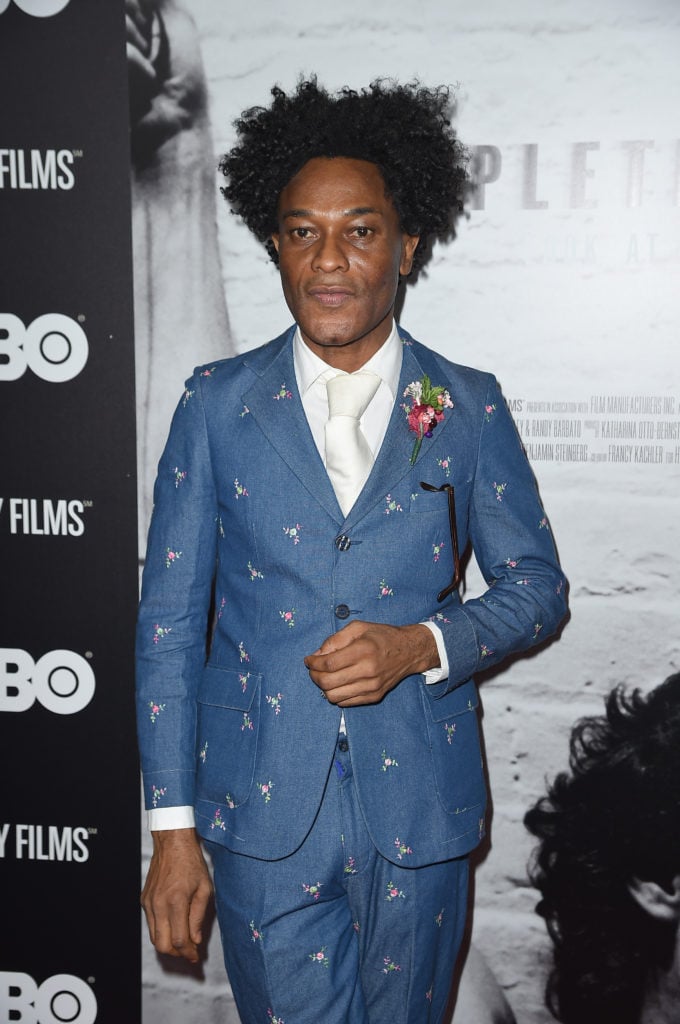
Photographer Ike Ude in New York City. (Photo by Nicholas Hunt/Getty Images)
The Nigerian-born, New York City-based photographer, publisher, author, and painter Iké Udé is an embodiment of an aesthete. He has topped glossy magazines’ International Best Dressed Lists, and has written his own compendium, 2008’s Style File: The World’s Most Elegantly Dressed.
Udé was exposed to the ritual of portraiture when at an early age he was subjected to regular sitting-sessions with his family members. When he embarked on a career in the field, he began to subvert the genre using satire of popular magazine covers that fetishized certain bodies. He cast himself as the model in his “Sartorial Anarchy” series, where he explores identity as a cultural and personal construct. In his self-portraits, he creates the props and costumes himself, and paints in the background in post-production.
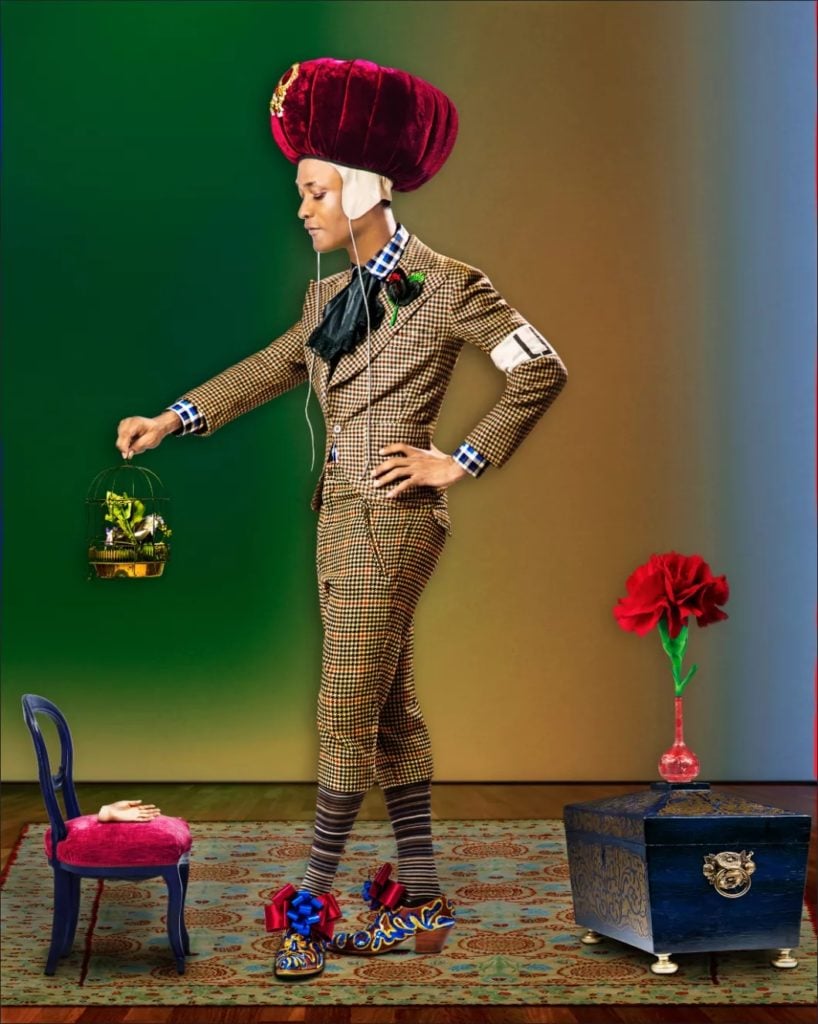
Iké Udé, Sartorial Anarchy #30 (2013). Courtesy of the artist and Leila Heller Gallery.

Clotilde Jiménez (à la Leon the Professional). Courtesy of the artist.
Born in 1990 in Honolulu, Hawaii, Jiménez is another artist making use of collage-techniques that combine magazine imagery with found materials to address his complex personal identity. He just wrapped up his MFA program at London’s Slade School of Fine Art, and already has a full calendar of shows on the docket for 2019, including a solo show in Seattle, plus inclusion in a group show at the ICA in Los Angeles. Right now, his work is on display at Half Gallery’s NADA booth in Miami, for a group show curated by Nathanial Mary Quinn.
How would you describe your personal style aesthetic?
I would define my style as basic-elegant chic à la Leon the Professional.
When I was first studying art in college I had a bit of a grundy art school look that’s a trend that probably won’t be going away any time soon. A piercing here and there with dingy tight jeans and disheveled hair. I don’t really regret it but now I’m a bit more polished and don’t care about trends. I only care about what feels good and comes natural to me.
Do you have any favorite brands?
My go-to would have to be Uniqlo, where I get all my basic and stylish clothes to handle to cold, wet, English weather.

Clotilde Jiménez, La Traición, Courtesy the Artist and Mariane Ibrahim Gallery
Do you see any correlation between how you present yourself and what your work ends up being? Does one inform the other?
I see myself collaging clothes together for the people in my work based off of things I’d wear. I think this started many years ago when I used to work back-stock for American Apparel. I’d spend hours receiving and stocking clothes, and some of the color block t-shirts began to enter the work. And even today, as I’m working I might take my white t-shirt off and cut it into a new shirt for one of my characters, as seen to the left in the diptych La Traición [above]. So for me there is kind of a direct correlation sometimes with my style and my work and I think in this way they inform each other at this point.
Who is your favorite designer? Why?
BALENCIAGAAAA! I’m inspired by their colors and sculptural forms that many of the designs have.
Do you have an all-time favorite article of clothing or accessory? It could be something you coveted and saved up for, or maybe something more sentimental?
I have an old grey sweatshirt with a portrait of Muhammad Ali on the front that says ‘float like a butterfly, sting like a bee’ and on either side of Ali is the American flag and the Puerto Rican flag. And seeing how my family is both Black American and Puerto Rican, it’s very sentimental for me, and has become a good luck charm. I do everything in it and it’s getting old and worn, but I wore it to my solo in Chicago a few months ago and it looked great.
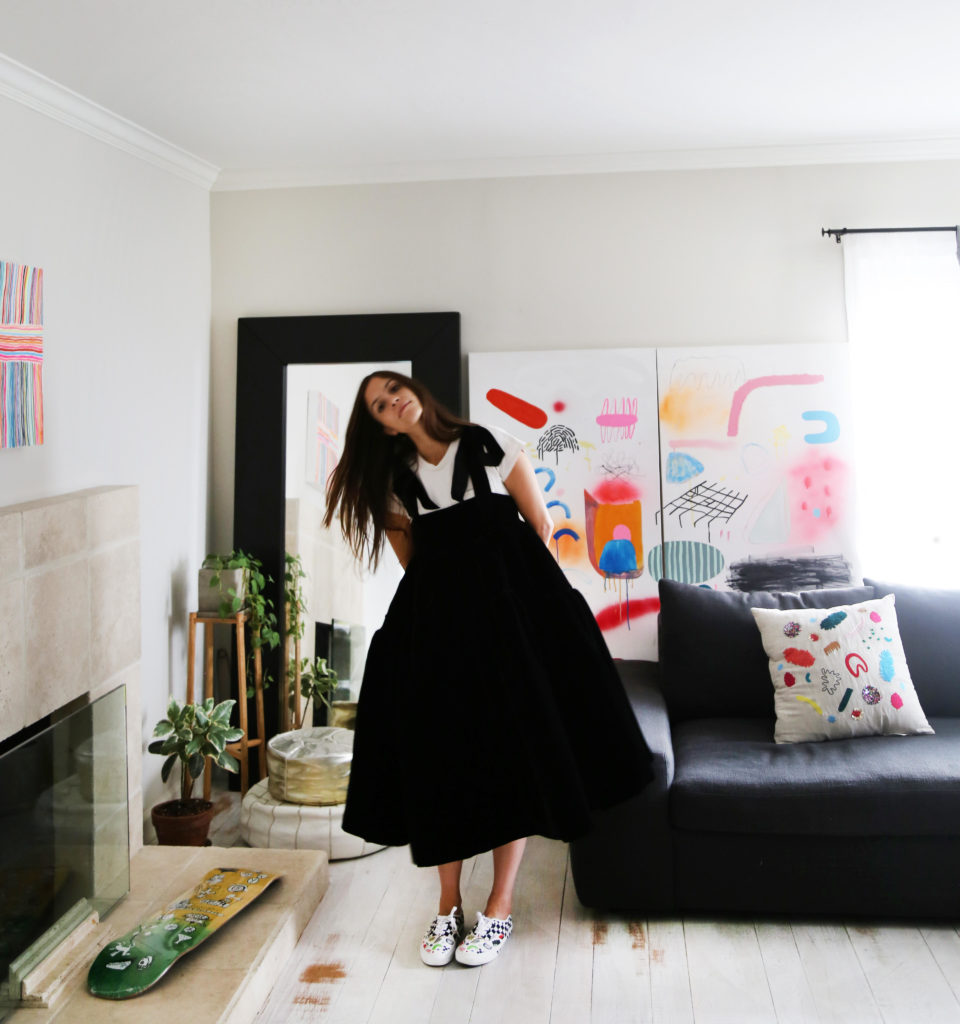
Kindah Khalidy 2018. Courtesy of the artist.
Kindah Khalidy’s candy-colored amoeba-like shapes have adorned everything from Vans sneakers to Facebook’s Menlo Park campus walls, and her Instagram virality has had her work picked up by brands including Unicef, Anthropologie, and Nordstrom.
The 29-year-old lives on the West Coast, and her textile-inspired art exudes a sunny, freewheeling attitude that appeals to young creatives. Case in point: If you follow Man Repeller’s Leandra Medine for long enough, you’ll notice it’s one of Khalidy’s paintings hanging in her New York City apartment, a constant presence in the background of the dozens of daily selfies.
How would you describe your personal style aesthetic?
I’ve always been drawn to tent-ish things like muumuus and caftans… I usually sport workwear, like jumpsuits and overalls in the studio because I need dozens of pockets, and I’m constantly getting doused in paint. Outside of the studio, I appreciate good draping and unique textiles.
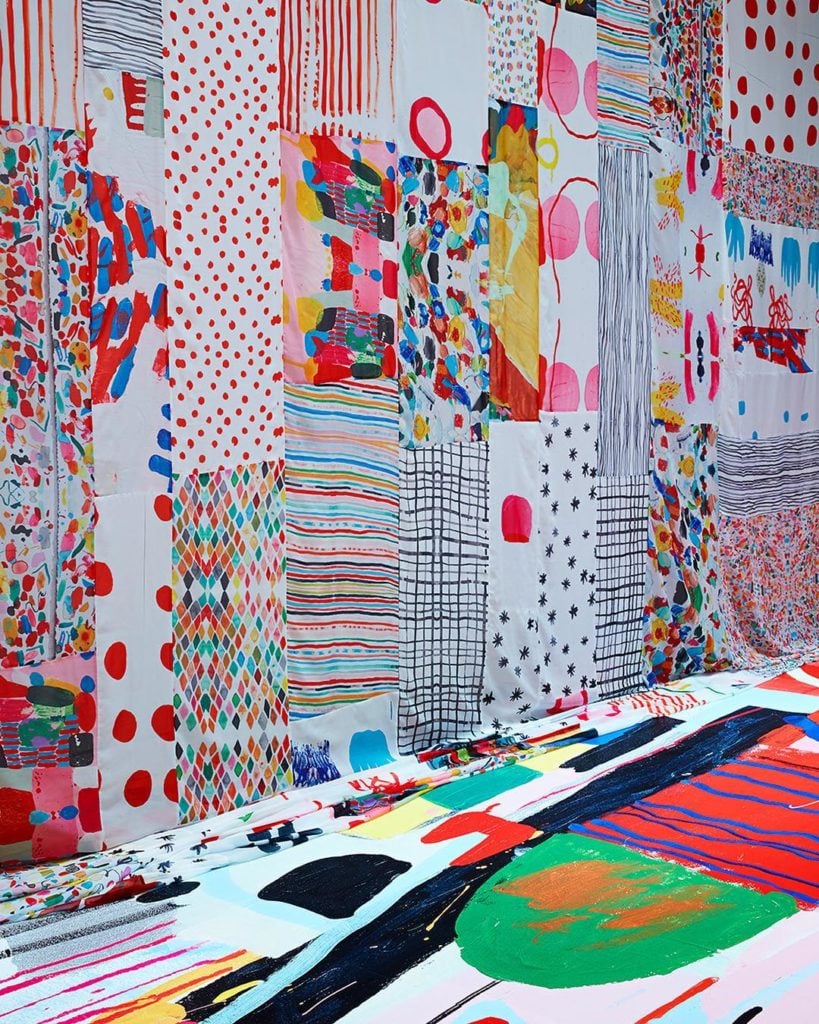
Installation view of “Kindah Khalidy: Surprise” at Chandran Gallery, 2018. Courtesy Chandran Gallery, photo: Mariko Reed.
Do you see any correlation between how you present yourself, and your artwork? Does one inform the other?
I make choices in my paintings that may look “accidental” but are in fact deliberate. I definitely share that mentality when I’m getting dressed.
What fashion designers or labels do you admire? Do you have an all-time favorite article of clothing or fashion accessory?
Kule, Cecile Bahnsen, Big Bud Press, Dusen Dusen, Levi’s, and Acne are on the current rotation. My current style muse is my son: lots of stripes and miniature overalls. I love the sneakers I designed for Vans. I wore them all the time growing up, so having pairs with my work on them feels really special.
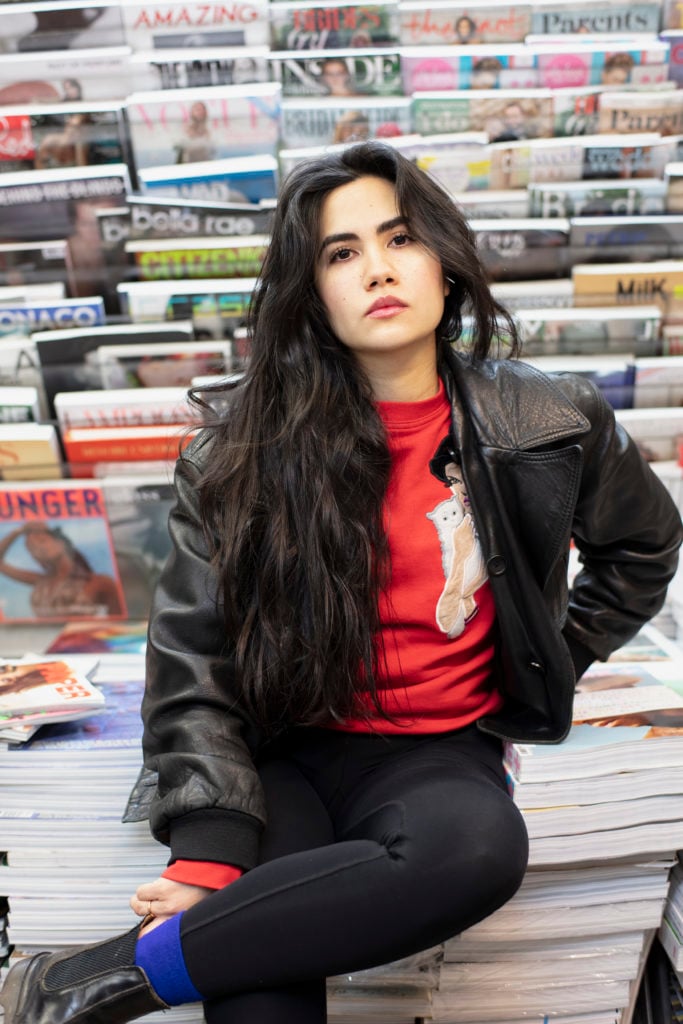
Mandy El-Sayegh. Photo: Patrick McNabb, Courtesy the artist and Lehmann Maupin, New York, Hong Kong and Seoul.
The London-based artist Mandy El-Sayegh made her US debut at Lehmann Maupin’s Chelsea outpost this November with “MUTATIONS IN BLUE, WHITE, AND RED,” a multi-media installation of her paintings, sculptures, and drawings. Her assemblage-style works involve layered pieces of newsprint and text, in that instance taken from the salmon-pink pages of The Financial Times (chosen as much for the fleshy color of its paper as for the subject matter of its stories).
How would you describe your personal style aesthetic?
Tough one. I would say—rather than defining a style—there are a couple of modes of dress dictated by my lifestyle: A lot of the time I’m in studio gear, so this has seeped into the style I describe as “everyday ninja,” i.e. androgynous all-black simple silhouette, a good hoodie. I adapt from the studio to going out with a pair of Chelsea boots. If I need to make more of an effort: Preppy punk, a mix of fitted tailoring, classic tweeds, and Docs.
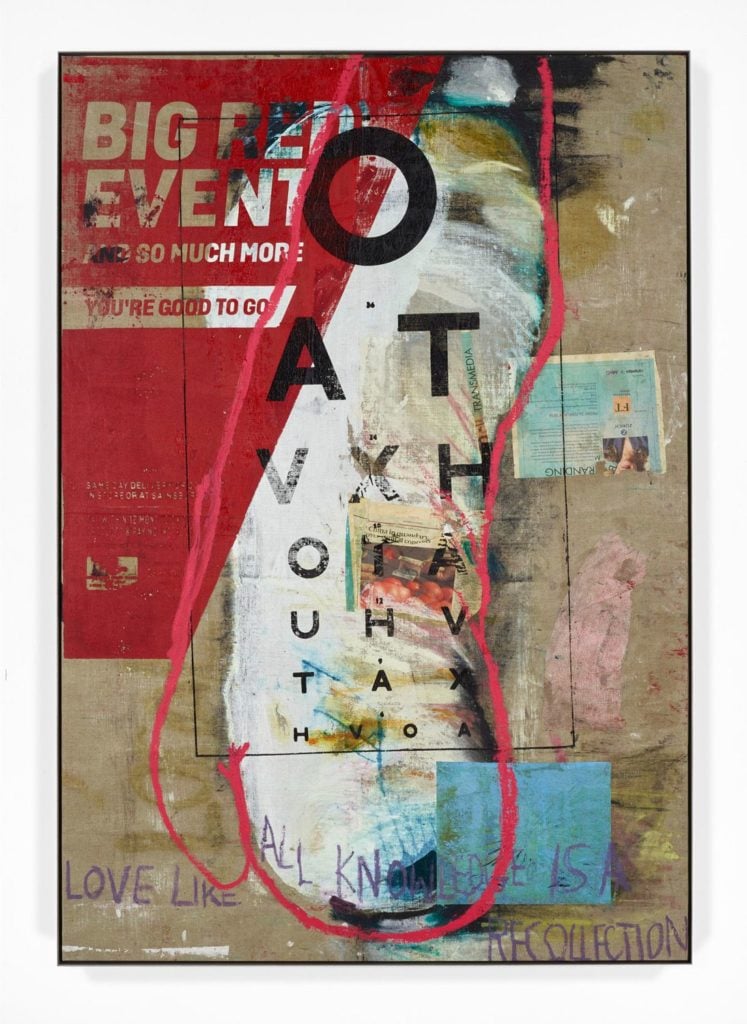
Mandy El-Sayegh, Red Event (2018). Courtesy of the artist and Lehmann Maupin, New York, Hong Kong and Seoul.
Do you see any correlation between how you present yourself and your artwork? Does one inform the other?
Artists in general tend to be sensualists by nature, so naturally there is going to be a sense of what looks and feels good. I haven’t seen a badly dressed artist. It can be plain or practical but not bad…
I don’t think a practice informs the style or vice versa—it’s all on the same continuum. I enjoy specific pieces and buy designer if its vintage/secondhand. It makes it more justified as a purchase, and the hunt is also part of the pleasure.
Who are your go-to fashion designers/brands? Do you have an all-time favorite article of clothing or accessory?
Vivienne Westwood for the clever tailoring. Moschino for its poppy toyishness and Lego color palette. I really like the collaboration that the French label Lamaire has with Uniqlo, Christophe Lemaire x Uniqlo U, a nice combination if you’re into a practical minimalist aesthetic. They’re now doing an Alexander Wang set of thermals which is looking like a good idea too.
I have a this Barbour wax jacket given to me as a birthday present from the Harrods kids section. I never wear it as the arms are a bit short, but I enjoy it as an object.
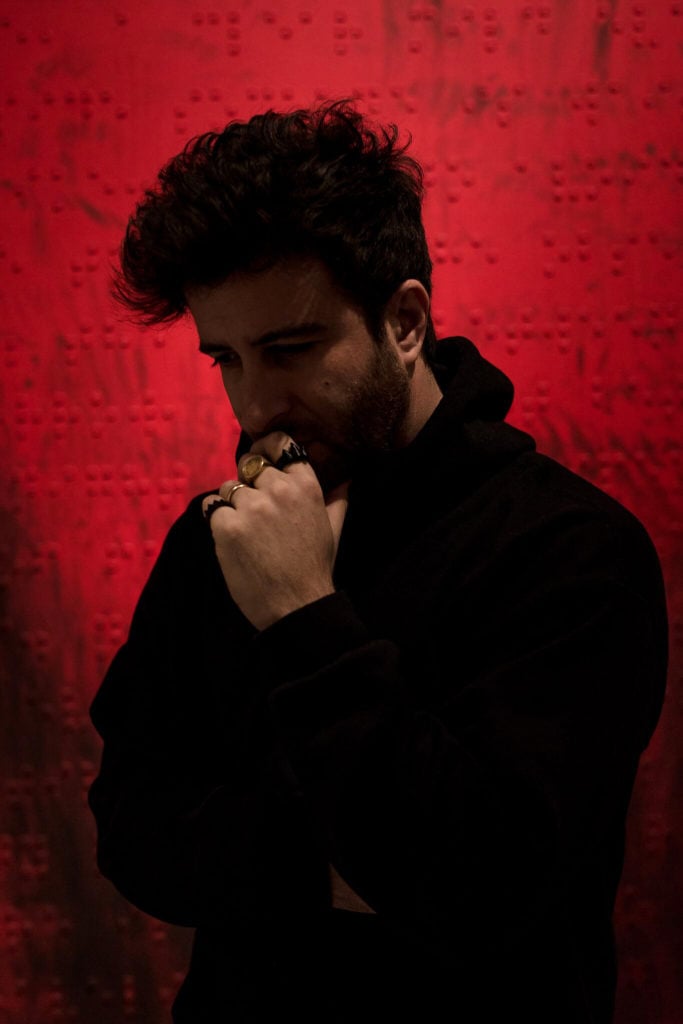
Roy Nachum, 2018. Courtesy of the artist.
The Jerusalem-born artist Roy Nachum has a knack for translating big ideas into universally accessible artwork—so much so that Grammy-winning musician and style-icon Rihanna chose his artistic vision to grace her 2017 album cover, Anti. The packaging earned Nachum a Grammy nomination as well, with its image of a Rih Rih as a child, holding a black balloon, with a gold crown covering her eyes [see below]. The Banksy-meets-Basquiat image is painted atop a canvas covered in braille text written by Chloe Mitchell, a muse to Kanye West and Jay Z, who also happens to collect Nachum’s work.
How would you describe your personal aesthetic?
I’m a minimalist; simple, black and white or monochromatic, with the attention on details. Clean lines and maybe a bold accessory…
I’m always painting so I need what I’m wearing to be functional. Pieces should fit together, be practical and transitional.

Roy Nachum, If They Let Us Pt. 1 (2015). Courtesy of the artist.
Do you see any correlation between how you present yourself and your artwork? Does one inform the other?
Who are your favorite fashion designers or brands? Do you have a favorite accessory or item of clothing?
I spent a lot of time in Tokyo, and most of my go-to brands are Japanese. And I always need a good pair of Nike’s.
My fang rings. These are a personal project I did years ago, sculpting objects and pieces I wanted to wear myself. Now they have become a part of me. There is Braille text on each band similar to my paintings and sculptures where I sculpt Braille poetry in relief—a metaphor for blindness to displaced values and desires.